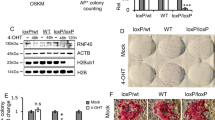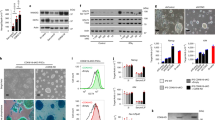Abstract
The activation-induced cytidine deaminase (AID; also known as AICDA) enzyme is required for somatic hypermutation and class switch recombination at the immunoglobulin locus1. In germinal-centre B cells, AID is highly expressed, and has an inherent mutator activity that helps generate antibody diversity2. However, AID may also regulate gene expression epigenetically by directly deaminating 5-methylcytosine in concert with base-excision repair to exchange cytosine3. This pathway promotes gene demethylation, thereby removing epigenetic memory. For example, AID promotes active demethylation of the genome in primordial germ cells4. However, different studies have suggested either a requirement5 or a lack of function6 for AID in promoting pluripotency in somatic nuclei after fusion with embryonic stem cells. Here we tested directly whether AID regulates epigenetic memory by comparing the relative ability of cells lacking AID to reprogram from a differentiated murine cell type to an induced pluripotent stem cell. We show that Aid-null cells are transiently hyper-responsive to the reprogramming process. Although they initiate expression of pluripotency genes, they fail to stabilize in the pluripotent state. The genome of Aid-null cells remains hypermethylated in reprogramming cells, and hypermethylated genes associated with pluripotency fail to be stably upregulated, including many MYC target genes. Recent studies identified a late step of reprogramming associated with methylation status7, and implicated a secondary set of pluripotency network components8. AID regulates this late step, removing epigenetic memory to stabilize the pluripotent state.
This is a preview of subscription content, access via your institution
Access options
Subscribe to this journal
Receive 51 print issues and online access
$199.00 per year
only $3.90 per issue
Buy this article
- Purchase on Springer Link
- Instant access to full article PDF
Prices may be subject to local taxes which are calculated during checkout




Similar content being viewed by others
References
Muramatsu, M. et al. Class switch recombination and hypermutation require activation-induced cytidine deaminase (AID), a potential RNA editing enzyme. Cell 102, 553–563 (2000)
Chaudhuri, J. et al. Transcription-targeted DNA deamination by the AID antibody diversification enzyme. Nature 422, 726–730 (2003)
Bhutani, N., Burns, D. M. & Blau, H. M. DNA demethylation dynamics. Cell 146, 866–872 (2011)
Popp, C. et al. Genome-wide erasure of DNA methylation in mouse primordial germ cells is affected by AID deficiency. Nature 463, 1101–1105 (2010)
Bhutani, N. et al. Reprogramming towards pluripotency requires AID-dependent DNA demethylation. Nature 463, 1042–1047 (2010)
Foshay, K. M. et al. Embryonic stem cells induce pluripotency in somatic cell fusion through biphasic reprogramming. Mol. Cell 46, 159–170 (2012)
Polo, J. M. et al. A molecular roadmap of reprogramming somatic cells into iPS cells. Cell 151, 1617–1632 (2012)
Buganim, Y. et al. Single-cell expression analyses during cellular reprogramming reveal an early stochastic and a late hierarchic phase. Cell 150, 1209–1222 (2012)
Meissner, A. Epigenetic modifications in pluripotent and differentiated cells. Nature Biotechnol. 28, 1079–1088 (2010)
Kim, K. et al. Epigenetic memory in induced pluripotent stem cells. Nature 467, 285–290 (2010)
Polo, J. M. et al. Cell type of origin influences the molecular and functional properties of mouse induced pluripotent stem cells. Nature Biotechnol. 28, 848–855 (2010)
Sommer, C. A. et al. Induced pluripotent stem cell generation using a single lentiviral stem cell cassette. Stem Cells 27, 543–549 (2009)
Smith, Z. D., Nachman, I., Regev, A. & Meissner, A. Dynamic single-cell imaging of direct reprogramming reveals an early specifying event. Nature Biotechnol. 28, 521–526 (2010)
Brambrink, T. et al. Sequential expression of pluripotency markers during direct reprogramming of mouse somatic cells. Cell Stem Cell 2, 151–159 (2008)
Sun, Y. et al. Critical role of activation induced cytidine deaminase in experimental autoimmune encephalomyelitis. Autoimmunity 46, 157–167 (2013)
Conticello, S. G. The AID/APOBEC family of nucleic acid mutators. Genome Biol. 9, 229 (2008)
Bhutani, N. et al. A critical role for AID in the initiation of reprogramming to induced pluripotent stem cells. FASEB J. 27, 1107–1113 (2012)
Robinton, D. A. & Daley, G. Q. The promise of induced pluripotent stem cells in research and therapy. Nature 481, 295–305 (2012)
Gore, A. et al. Somatic coding mutations in human induced pluripotent stem cells. Nature 471, 63–67 (2011)
Hussein, S. M. et al. Copy number variation and selection during reprogramming to pluripotency. Nature 471, 58–62 (2011)
Mayshar, Y. et al. Identification and classification of chromosomal aberrations in human induced pluripotent stem cells. Cell Stem Cell 7, 521–531 (2010)
Akalin, A. et al. Base-pair resolution DNA methylation sequencing reveals profoundly divergent epigenetic landscapes in acute myeloid leukemia. PLoS Genet. 8, e1002781 (2012)
Krueger, F. & Andrews, S. R. Bismark: a flexible aligner and methylation caller for Bisulfite-Seq applications. Bioinformatics 27, 1571–1572 (2011)
Mortazavi, A., Williams, B. A., McCue, K., Schaeffer, L. & Wold, B. Mapping and quantifying mammalian transcriptomes by RNA-Seq. Nature Methods 5, 621–628 (2008)
Vuong, B. Q. et al. Specific recruitment of protein kinase A to the immunoglobulin locus regulates class-switch recombination. Nature Immunol. 10, 420–426 (2009)
Nagy, A., Gertsenstein, M., Vintersten, K. & Behringer, R. Manipulating the Mouse Embryo: A Laboratory Manual 3rd edn (Cold Spring Harbor, 2003)
Joyner, A. L. Gene Targeting: A Practical Approach 2nd edn (Oxford Univ. Press, 2000)
Ehrich, M. et al. Quantitative high-throughput analysis of DNA methylation patterns by base-specific cleavage and mass spectrometry. Proc. Natl Acad. Sci. USA 102, 15785–15790 (2005)
Acknowledgements
We thank G. Mostoslavsky for the gift of reprogramming vectors. A. Melnick provided advice and consultation. We are grateful to T. Honjo for AID-knockout mice, and N. Papavasiliou for assistance in designing genotyping PCR primers. The Epigenomics Core Facility of Weill Cornell Medical College carried out the bisulphite sequencing and provided consultation. This study was supported by National Institutes of Health grant HL056182 (T.E.), AI072194 (J.C.) and National Science Foundation CAREER grant 1054964 (O.E.).
Author information
Authors and Affiliations
Contributions
R.K. conceived the study, carried out experiments, and wrote the manuscript. L.D., N.S., T.-C.L., P.F. and S.M.-D. carried out experiments. A.A.Z. and A.-K.H. provided essential reagents and expertise. J.C. conceived the study and wrote the manuscript. O.E. conceived the study, carried out computational and informatics analyses, and wrote the manuscript. T.E. conceived the study and wrote the manuscript.
Corresponding author
Ethics declarations
Competing interests
The authors declare no competing financial interests.
Supplementary information
Supplementary Information
This file contains a list of abbreviations used in the text, Supplementary Figures 1-16 and Supplementary Tables 1-3. (PDF 6803 kb)
Rights and permissions
About this article
Cite this article
Kumar, R., DiMenna, L., Schrode, N. et al. AID stabilizes stem-cell phenotype by removing epigenetic memory of pluripotency genes. Nature 500, 89–92 (2013). https://doi.org/10.1038/nature12299
Received:
Accepted:
Published:
Issue Date:
DOI: https://doi.org/10.1038/nature12299
This article is cited by
-
Aberrant APOBEC3C expression induces characteristic genomic instability in pancreatic ductal adenocarcinoma
Oncogenesis (2022)
-
Emerging role of G9a in cancer stemness and promises as a therapeutic target
Oncogenesis (2021)
-
Genetic and epigenetic determinants of diffuse large B-cell lymphoma
Blood Cancer Journal (2020)
-
Understanding the Structure, Multimerization, Subcellular Localization and mC Selectivity of a Genomic Mutator and Anti-HIV Factor APOBEC3H
Scientific Reports (2018)
-
Mutations in human AID differentially affect its ability to deaminate cytidine and 5-methylcytidine in ssDNA substrates in vitro
Scientific Reports (2017)
Comments
By submitting a comment you agree to abide by our Terms and Community Guidelines. If you find something abusive or that does not comply with our terms or guidelines please flag it as inappropriate.



